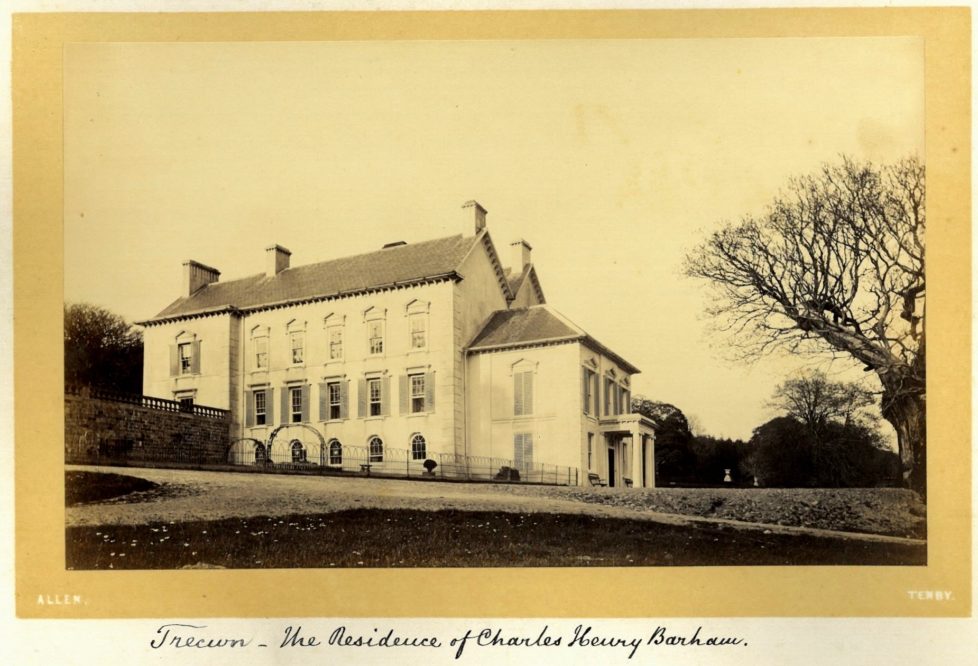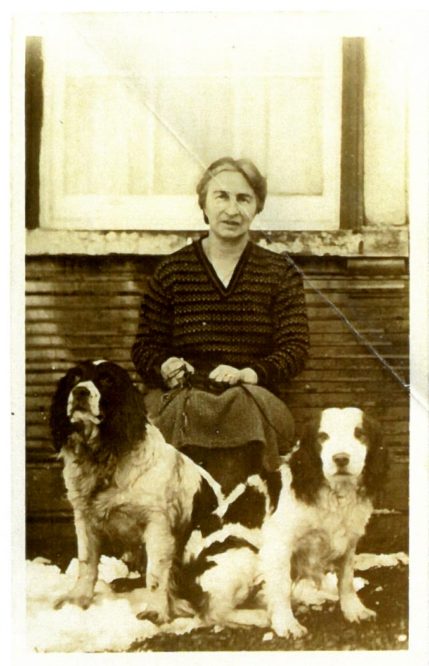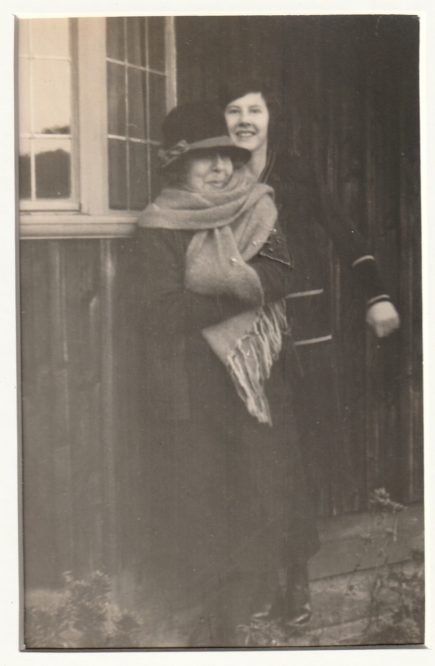House of Dogs: The Last Squires of Trecwn, Part 10 – The Last of the Barhams

We continue our series exploring the history of a Pembrokeshire estate and its colourful family.
Howell Harris
Cyril Barham left little trace in the public record until in 1926, at the age of 54, he became, in his own mind at least, the rightful heir to his father, whom he had not seen for years, and who had disinherited him for the third and final time nine years earlier.
There are huge gaps in his life where, thus far, there seems to be no surviving material about what he was doing, or where, and the few tantalising pieces of evidence raise almost more questions than they answer.
After his studies in Oxford were over he moved to Henley, showing up in the 1901 Census as Hugh S. Robins, the head of his small household, “living on his own means” (so was his father still providing an allowance?) with a much older woman (49 to his 28), Ellaline H. Vaughan, who described herself as his sister, which she certainly was not, and a widow, and their elderly servant.
His next appearance was as Cyril Hugh Sackville Robins, in the magistrates’ court at Oxted in Surrey in May 1904, where he was a witness in the trial for theft of a woman now described as Eleanor Robins Vaughan and her equally respectable-looking sister, a charge on which they were both convicted.
By that time he was living in West Ealing, working as a city solicitors’ clerk and visiting Mrs Vaughan at her home in Balham. The newspaper reporting this interesting fact ended its sentence with an exclamation mark, just like this one!
He had by then married another older woman, Mary Ellis, then about 41, at Maidenhead in January 1904. By 1908, when his beloved first wife died, he was living at Gerrards Cross, and referring to himself (and his father) as Robins-Barham.
He had been there for two years and still worked in London, but not on a very regular basis.
We know this because in June 1909 he was in court again, charged with travelling without a railway ticket, and the magistrates accepted his complicated explanation for why this was not intentional.
It was not long before he remarried. Or did he? The sole record of his and his second wife’s marriage dates to October 1931, in Bournemouth.
Cyril’s second wife, or “wife,” was Mary Henrietta Caroline Hughesdon, born in 1877, i.e. just four years younger than he was.
She was the daughter of a retired Indian Civil Servant and a member of a scholarly Catholic family from Wimbledon. In July 1910 Mary had a daughter, Leileen (perhaps a diminutive of Ellaline?) Margaret, known as Dorothy, in 1913 a son, Cecil, and there was also another daughter Jeanne.
The unusual aspects of both of his marriages — the age gap the first time, the Catholicism and for some reason not actually getting officially married with the second — may explain why he did not tell his father that he had got married at all the first time, or that he had “married again” until his first child was born.

Cyril served in the Army during the First World War, despite the fact that he was 40 when it started, but this may be the reason why, by the 1920s, he had knocked some years off his reported age, a small rejuvenation that lasted until his death; Mary knocked a few more off hers to match.
His college record says that he joined the Durham Light Infantry, a fine fighting unit, presumably because this is what he told them.
However, his service record lists him as a Second Lieutenant/Lieutenant in the rather less splendid but nonetheless vital Ordnance Corps.
After the war he worked as a clerk at the Ministry of Housing, and moved to a small semi in West Ealing. But he kept a house at Gerrards Cross, which he rented out.

We only know this because his unconventional technique of trying to get rid of an unwanted tenant — entering the property when nobody was there, fusing the lights, taking away the gas key, and putting an obstruction up the chimney — got him back into the magistrates’ court, where his testimony was not believed and five guineas of damages levied.
Cyril’s relations with his father went through bad and worse patches. Francis’s letters came to reveal a “settled and continuous hatred.”
He had an explanation for disinheriting all of his children in 1912 — their “abominable and unnatural” conduct towards him — and Cyril in particular: he had “wasted his time with his mother after giving his word that he would have nothing to do with her.” “By his conduct he has forfeited my regard and I disown him as my son.”
In 1913 there was a partial reconciliation, but this truce did not last long, and in 1917 — the year Francis proposed to Ada Page and was rejected — he was cut out again, and this time he stayed out.
Through the 1920s there was little physical contact between father and son — one meeting in 1924 — but there were some letters. None of the children visited in all the time that Ada was at Trecwn.
His older daughter Winifred tried to introduce Francis to his youngest granddaughter Margaret, born in 1917, in 1921 or 1922 when he was wintering in Croydon, but without success. Ada Page would not let them in.

Winifred
Winifred played an important role in the dramas that followed their father’s death, and led a sufficiently interesting life that she deserves more than a passing mention.
After her spells as a teacher, a nun, and a companion to her mother, at some point during the 1910s, probably during the war, she became a nurse, the occupation she would continue to have until the end of her life.
That was probably what she was doing in Cairo late in 1916 when, according to Margaret’s birth certificate and family tradition, Winifred met and married her father, Lieutenant John Barton of the 5th Regiment of the famed Australian Light Horse.
By August 1917, when Margaret was born, and perhaps sooner, she was back in London, and by the time she registered the birth John Barton was dead.
Winifred was 42, a widowed mother, her own mother was recently dead too, and her father was distant and indifferent. For the rest of her life she would have to support herself and Margaret by her own efforts.
Thanks to John Barton, Winifred had a new surname and the respectable status of a war widow, as well as a baby daughter. But she neither asked for nor received a widow’s pension, much as she needed it.
Family tradition had it that she did not claim a pension because her family did not want her to.
Perhaps the lack of any evidence of her marriage, apart from the name on the birth certificate, was a more substantial obstacle. The family explained this to itself by the fact that everything had happened in Cairo and the paperwork had been lost.
John Barton is very elusive. The Commonwealth War Graves Commission only records one man of that name who died in the Australian army in World War 1, and he was an infantry Private, falling in France in July 1916.
Two Bartons who were members of the Australian Light Horse did die during the war, but both were Troopers, neither was a John, and one died too early, one too late. Altogether at least thirteen Bartons served in the Light Horse, none of them Johns, and none of them a Lieutenant.
The Australian War Memorial has more John Bartons in other units, but none fits the time frame — alive until October-November 1916, dead by August-October 1917 — or the rank any better.
There was a Frederick John Barton (known as Mickey, probably because of his Irish background) — a wiry larrikin and horse-breaker in his early 30s from the Queensland outback, where the Fifth was mostly recruited.
He arrived in theatre early in 1916 and returned home safely three years later to a long married life. In 1916 he served in base camps in the outskirts of Cairo and did spend a few days in military hospital in April, with mumps.
The Fifth Light Horse was busy fighting the Turks in the Sinai desert while Winifred and her John Barton must have been courting, but Acting Sergeant Barton was lucky and still an instructor back at base.
The difficulty of finding even an unlikely candidate for “John Barton”, and perhaps the futility of making the effort, is compounded by the problem of pinning down the other side of Winifred’s story — that she was a nurse in Egypt.
There is no record of her in the British Red Cross’s huge database of members of the Voluntary Aid Detachments — the most common route by which untrained women became nurses during the war — among the thirteen other Barhams present.
Nor is she in the National Archives’ list of Army nurses, as she might have been if trained. Absence of evidence does not mean evidence of absence, but it does at least raise a question
An alternative explanation, purely speculative, is that John Barton was a convenient fiction, a man who never was, and could never be traced.
The surname Barton would have required no change at all to any items bearing Winifred’s initials, and minimal alteration to her name on, for example, luggage. It would have been easy to get used to as a new signature, and equally easy to explain or gloss over any forgetful lapses back into the old one.
And Cairo was an awfully long way away for anybody to check anything, even if they had wanted to.
This small, harmless invention would have preserved Winifred’s respectability, guaranteed Margaret’s legitimacy, and provided her with an origin story — dead hero’s daughter — which, according to her children, she never questioned.
She would have liked to know more about her father, but her mother was understandably reluctant to talk about him.Winifred was poor, and could have done with a pension, but at least she had a profession, and for the rest of her life she depended on nursing for her income and also her accommodation.
In 1921 she was back in South Wales, working and living at the Cottage Hospital in Aberaeron.
She had cut five years off her age, perhaps for the same reason as Cyril — employability — but maybe also because a daughter of 4 fitted better alongside a war-widow mother of 41 than one of 46. Margaret was boarding with the Sisters of Mercy at St Gerard’s Convent School in Bangor, Caernarfonshire, a long and very tedious railway trip to the north.
By 1926 she was working with a nurses’ co-op and living in its hostel in Cardiff. She still could not afford not to work, or to provide a home for Margaret. Instead the little girl stayed in a more convenient convent school in Swansea most of the year.
Mother and daughter could only live together during the summer holidays, when Winifred took a job looking after two boarding-school boys whose parents worked abroad and who had no other family to care for them, in a seaside cottage in Cwm-yr-Eglwys, just eight miles from Trecwn.
So this resourceful, independent woman had the best connections to North Pembrokeshire of any of her siblings, despite her own father’s continuing refusal to have anything to do with her.
A Bolt from the Blue
On the 10th December 1926, Cyril received a letter that their old governess Henriette Miles (ironically, the person who had drafted the 1912 will that disinherited them) had written from her home in Hertfordshire on the 9th. She signed with the name Francis and other family members had called her since the early 1880s, “Minouche” [“Kitten” or “Pussy”].
She was letting him and his sisters know that their father’s body would be transported to London for cremation — just the day before he was actually about to be cremated in Pontypridd, so not the most helpful information.
This was not Henriette’s fault. She assumed that Cyril and his sisters must already have been informed of the old man’s death, and that she was simply passing on the information about funeral arrangements that Ada Page had given her.
So Henriette also missed the cremation of a man she had known, loved, lived with, and supported for most of the last 43 years.
Winifred was the only family member who made it to Pontypridd, but this was only because she had her own information sources from friends in and around Fishguard and lived close enough to make it there on the Saturday morning.
Ada and the executors’ apparent deception, and the final disappearance of any prospect of inheritance, sent Cyril on a mission of vengeance and the recovery of his and his sisters’ rights that would occupy the courts and fill the newspapers over the next two years.
His attack was two-pronged. He mounted a prosecution of the Rev. David Jenkyn Evans, a retired cleric with a hitherto unblemished record, on a charge of perjury (for falsely completing the section of his father’s cremation form stating that next of kin had been told), the first such charge under the 1902 Cremation Act.
And he disputed his father’s will, on the grounds that the old man was insane, sexually abnormal, and mentally incompetent to have issued his 1912 will or any of the numerous codicils since.
The plan was to invalidate them all and have his father declared intestate, which would result in Cyril and his sisters sharing everything. And “everything” was quite a rich prize: Francis left £50,988 gross in property plus other wealth of £19,445 — altogether £70,543, or c. £15,300,000, relative to average wages then and now.
You can find the rest of the episodes here.
Support our Nation today
For the price of a cup of coffee a month you can help us create an independent, not-for-profit, national news service for the people of Wales, by the people of Wales.




